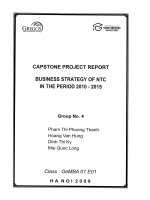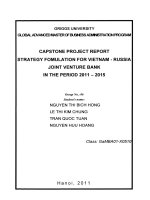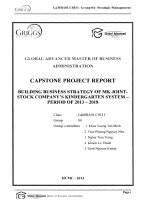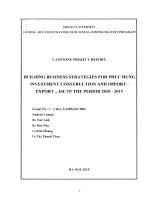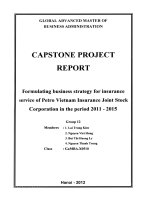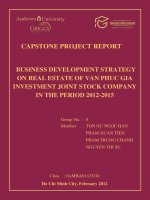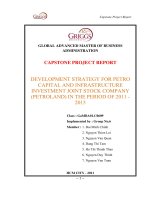Strategy for coffee export business of Thanh Ha production export-import joint stock company (Haforexim) in the period 2011 - 2015
Bạn đang xem bản rút gọn của tài liệu. Xem và tải ngay bản đầy đủ của tài liệu tại đây (1.92 MB, 109 trang )
CAPSTONE PROJECT REPORT
STRATEGY FOR COFFEE EXPORT
BUSINESS OF THANH HA
PRODUCTION EXPORT-IMPORT
JOINT STOCK COMPANY
(HAFOREXIM) IN THE PERIOD
2011 - 2015
Le Quang Thai
Ho Thi Thanh Nguyen
Nguyen Dang Thanh
Nguyen Trung Thanh
Ho Nghia Cong
Class: GaMBA01.C0209
HO CHI MINH CITY 2011
2011 GLOBAL ADVANCED MBA PROGRAM (Class C02) Group No.5
GRIGGS UNIVERSITY
GLOBAL ADVANCED MASTER OF BUSINESS
ADMINISTRATION PROGRAM
CAPSTONE PROJECT REPORT
STRATEGY FOR COFFEE EXPORT
BUSINESS OF THANH HA
PRODUCTION EXPORT-IMPORT
JOINT STOCK COMPANY
(HAFOREXIM) IN THE PERIOD
2011 - 2015
Le Quang Thai
Ho Thi Thanh Nguyen
Nguyen Dang Thanh
Nguyen Trung Thanh
Ho Nghia Cong
Class: GaMBA01.C0209
HO CHI MINH CITY 2011
Capstone Project Report - Group 5
REASSURE WORDS
We, Group 5, pledge that the content of the capstone project
report has not been summitted to any MBA programs as well as
any programs in any other level.
We also commit that this capstone project report is a great
effort by all group members to complete it. The results, analysis
and conclusions in this report (except quoted parts) are the result
of teamwork of our group.
ON BEHALF OF GROUP 5
GROUP LEADER
Le Quang Thai
Capstone Project Report - Group 5
ACKNOWLEDGEMENTS
In order to complete the capstone project report, first of all
our group would like to thank sincerely to Center For Education
Technology & Career Development of Vietnam National
University, and Griggs University to help us acquired knowledge
through the program of Global Advanced Master of Business
Administration.
Our group would like to thank sincerely and deeply to all
teachers who have enthusiasm to guide us to fulfill the capstone
project report as well as big-hearted teaching, assisting, and
facilitating for us to complete this course.
We also send our sincere thanks to family, fellow brothers
and sisters in Thanh Ha Production Export-Import Joint Stock
Company (HAFOREXIM), classroom management members,
and GaMBA01.C02 classmates had helped, encouraged, and
supported our group to complete the program and our work.
ON BEHALF OF GROUP 5
GROUP LEADER
Le Quang Thai
Capstone Project Report - Group 5
TABLE OF CONTENTS
PREFACE
1
1. Reason selecting theme.
1
2. Purpose to research.
2
3. Objects and scopes to research.
2
4. Methods to research.
2
5. Sense of science and reality about theme.
3
6. All limits of theme.
3
7. Structure of capstone project report.
3
CHAPTER I. THEORICAL BASIS ABOUT STRATEGY FOR
COFFEE EXPORT BUSINESS
4
1.1. Concepts.
4
1.1.1. Concepts about strategy.
4
1.1.2. Concepts about business strategy.
4
1.1.3. Concepts about strategic management.
5
1.2. Role of business strategy.
6
1.3. Process to build business strategy.
7
1.4. Models to build business strategy.
8
1.4.1. General environment PEST model.
8
1.4.2. The five forces of competition model of Michael Poter.
11
1.4.3. General model - SWOT analysis.
13
1.4.4. Some models and other matrix analysis.
15
1.4.4.1. Internal factor evaluation matrix.
15
1.4.4.2. Competitive profile matrix.
16
1.4.4.3. Strategic Position and Action Evaluation (SPACE) matrix.
18
1.4.4.4. Quantitative strategic planning matrix (QSPM).
19
Summary of Chapter I.
20
Capstone Project Report - Group 5
CHAPTER II. REAL SITUATION OF BUSINESS OPERATIONS
FOR COFFEE EXPORT OF THANH HA PRODUCTION
EXPORT-IMPORT JOINT STOCK COMPANY
21
2.1. Overall about HAFOREXIM.
21
2.1.1. Process to be taken form and developed HAFOREXIM.
21
2.1.2. Business careers.
21
2.1.3. Organization model of HAFOREXIM.
22
2.1.4. The labor situation of the Company.
23
2.1.5. Vision, Mission and core values.
25
2.1.5.1. Visison.
25
2.1.5.2. Misison.
25
2.1.5.3. Core values.
25
2.1.6. Results of business operations for coffee export of the Company
from 2006 to 2010.
25
2.1.6.1. Result of business operation of the Company.
25
2.1.6.2. Quantity - Export turn-over of the Company.
26
2.1.6.3. Comparing turn-over of export and profit of coffee commodity with
total turn-over of export and total profit of the Company.
27
2.2. Analysis of situation for coffee export business of HAFOREXIM.
29
2.2.1. Overall about coffee sector.
29
2.2.1.1. Situation of manufacture and consumption towards the coffee on the
world.
30
2.2.1.2. Situation of manufacture and consumption Vietnam coffee.
33
2.2.2. Analysis of business environment of the Company
38
2.2.2.1. Analysis according to general environment PEST model.
38
2.2.2.2. Analysis according the five forces of competition model of Michael
Poter.
50
Capstone Project Report - Group 5
2.2.2.3. Analysis according to general model - SWOT.
56
2.2.2.4. Analysis according to other models.
61
2.3. General assessment about situation for coffee export of the
Company.
64
2.3.1. Advantages.
64
2.3.1.1. All objective advantageous factors.
64
2.3.1.2. Subjective advantageous factors.
65
2.3.2. Existence.
66
2.3.3. Existed causes.
66
2.3.3.1. Toward the State authorities.
66
2.3.3.2. Toward companies and enterprises in the industry.
66
2.3.3.3. Toward the farmers.
67
Summary of Chapter II.
68
CHAPTER III. STRATEGICAL ERECTION OF COFFEE
EXPORT BUSINESS FOR THANH HA PRODUCTION
EXPORT-IMPORT JOINT STOCK COMPANY IN THE
PERIOD 2011 - 2015
69
3.1. Basing to strategical suggestion.
69
3.1.1. Basing into developed target of the Company.
69
3.1.2. Basing into ability, occasions and challenges of the Company.
70
3.2. Strategy towards the export business of the coffee for Thanh Ha
Production Export-Import Joint Stock Company in the period of 2011 –
2015
72
3.2.1. Proposal strategies.
72
3.2.2. Strategy selection.
73
3.2.2.1. Some criterias to select strategy.
73
3.2.2.2. Analysis QSPM matrix to select strategy.
73
Capstone Project Report - Group 5
3.3. Solutions enforcing strategy.
75
3.3.1. Solutions about source providing coffee.
75
3.3.2. Solutions about science and technology.
77
3.3.3. Solutions about finance.
79
3.3.4. Solutions for development and penetration into market.
81
3.3.4.1. Penetration and market development.
81
3.3.4.2. Some measures about development and penetration into markets.
81
3.3.5. Solutions about organization structure.
82
3.3.6. Solutions developing human resources.
85
3.3.6.1. Solutions erecting the line-up for cadres.
85
3.3.6.2. To build the regulations to commend and reward - the discipline - the
standard and the assessment of the cadres in the business.
88
3.4. Some petitions.
89
3.4.1. Toward State.
89
3.4.1. Toward HAFOREXIM.
90
Summary of Chapter III.
91
CONCLUSION
92
Appendix 1: Coffee production in the world
Appendix 2: Robusta coffee production in the world
Appendix 3: Arabica coffee production in the world
Appendix 4: Area and production of Vietnam coffee from 2001 to 2010
Capstone Project Report - Group 5
LIST OF ABBREVIATIONS
Abbreviation
Full words
AFTA
ASEAN Free Trade Area
AGRIBANK
Vietnam Bank for Agriculture and Rural Development
AS
Attractiveness Scores
ASEAN
Association of South East Asian Nations
CA
Competitive Advantage
ES
Environment Stability
FS
Financial Strength
GDP
Gross Domestic Products
HAFOREXIM
Thanh Ha Production Export-Import Joint Stock Company
IS
Industry Strength
PEST
Political Economics SocialCultural Technological
QSPM
Quantitative Strategic Planning Matrix
R&D
Research and Development
SO
Strengths Opportunities
SPACE
Strategic Position and Action Evaluation
ST
Strengths Threats
SWOT
Strengths Weaknesses Opportunities Threats
TAS
Total Attractiveness Scores
USD
United State Dollar
VAT
Value Added Tax
VICOFA
Vietnam Coffee and Cocoa Association
VNĐ
Vietnamese Currency
WO
Weaknesses Opportunities
WT
Weaknesses Threats
WTO
World Trade Organization
MBA
Master of Business Administration
Capstone Project Report - Group 5
FOB
Free On Board
USA
United State of America
BIDV
Bank for Investment and Development of Vietnam
CEPT
Common Effective Preferential Tariff
Capstone Project Report - Group 5
LIST OF TABLES
No.
Title table
Page
1
Table 1.1. Internal factor evaluation matrix
16
2
Table 1.2. Sample of Competitive Profile Matrix
17
3
Table 1.3. QSPM
19
4
Table 2.1. The labor situation of HAFOREXIM
24
5
Table 2.2. Results of business operations of the Company from
2006 to 2010
26
6
Table 2.3. Comparing turn-over of export and profit of coffee
commodity with total turn-over of export and total profit of
HAFOREXIM from 2006 - 2010.
28
7
Table 2.4. Average consumed forces of coffee/person/year in some
markets of coffee import on the world in 2009.
32
8
Table 2.5: Quota in comparison with two kinds of coffee seeds as
Arabica and Robusta
34
9
Table 2.6. Top Export Enterprises of Viet Nam from January 2010
to October 2010
38
10
Table 2.7. Stipulations of Maroc custom about the tax level of
coffee import
40
11
Table 2.8. The level of impact of the five forces of competition
model of Michael Poter on HAFOREXIM.
55
12
Table 2.9. SWOT Matrix of HAFOREXIM.
56-60
13
Table 2.10. Internal factor evaluation matrix of HAFOREXIM
61
14
Table 2.11. Competitive profile matrix of HAFOREXIM
62
15
Table 2.12. SPACE matrix of HAFOREXIM
63
16
Table 3.1: Analysis quantitative strategic planning matrix QSPM
74
Capstone Project Report - Group 5
LIST OF FIGURES, GRAPHS
No.
Title of figures, graphs
Page
1
Figure 1.1. Comprehensive strategic management model
6
2
Figure 1.2. General environment PEST model
9
3
Figure 1.3. The five forces of competition model of Michael Poter
13
4
Figure 1.4: SPACE Matrix
18
5
Figure 2.1. Organization chart of HAFOREXIM
24
6
Figure 2.2: Quantity and turn-over of coffee bean export of
HAFOREXIM from 2006 - 2010.
26
7
Figure 2.3: Profit rate of export coffee commodity of HAFOREXIM
from 2006 - 2010
29
8
Figure 2.4. Quantity and turn-over for coffee bean export of Viet
Nam
37
9
Figure 2.5. Market share of 10 top nations imported Vietnam coffee
in 2010
37
10
Figure 2.6. Evolvement of the FOB price of coffee through all times
in 2010
42
11
Figure 2.7. Evolvement of domestic price of coffee through all times
in 2010
42
12
Figure 2.8. Fluctuation about exchange rate between VND and USD
through all time from January 2009 to September 2010.
45
13
Figure 2.9. Aggressive picture of the Company
64
14
Figure 3.1 : Model of source supplying coffee
75
15
Figure 3.2: Organization structure according to functions
83
Capstone Project Report - Group 5
1
PREFACE
1. Reason selecting theme.
The coffee is the commodity reserving for the manufacture and the business
importantly with the economic foundation of our country. The Vietnam Coffee
Sector is more and more asserted through daily about the own position on the world
coffee market From a small country manufactured the coffee up to now that
Vietnam was rised to the second position on the world after Brazil. Annually, the
coffee sector brought back to the country with a quantity of turn-over considerably
and having been already solved by the employment and stabilized the life for
hundreds of households throughout in the mountainous regions, especially in
Plateau Regions. Those achievements were asserted the position, the role of the
coffee sector in the national economic foundation contributing into the career to
industrialize, to modernize the country.
Thanh Ha Production Export-Import Joint Stock Company (HAFOREXIM) is
an enterprise then it is well asserting the own position to be worthy as one in the main
force business careers of Company, mainly as the coffee export. The Company
contributed no small into the developed process of Vietnam Coffee Sector.
However, in the recent years, it was due by the violent competition from the
other nations, since then Vietnam had been encountered by many difficulties in the
export for this commodity. The market integration of the foreign groups and
companies, and foreign representative offices has joined into the market share for
the export coffee business in Vietnam and competed directly with the Company. In
that side, the demands of world market towards the coffee quality is more and more
high through daily, and all products to be more and more diversified through daily,
together with the competitive prices … The matters are the extreme challenges to be
confronted. The Company needs a strategical orientation correctly at the present
stage in order to develop more strongly.
To start from this real demand in plus with the knowledge was learned
whereby our fifth group is brave to select the theme towards “Strategy for Coffee
Capstone Project Report - Group 5
2
Export Business of Thanh Ha Production Export-Import Joint Stock Company
(HAFOREXIM) in the period 2011 - 2015” for the capstone project report of the
group.
2. Purpose to research.
- It is to research in order to clarify about a business environment of the
coffee export from HAFOREXIM through all periods towards the matter to learn
from experiences of the advantages and the existences with the aim to perfect the
strategical erection for the coffee export business of HAFOREXIM;
- It is to research in order to bring out all solutions enforcing the strategy;
- It is to research in order to build all petitions with the Government,
sectores, and grades concerning to all prior matters, policies in the best support for
the Export of Vietnam Coffee Sector.
3. Objects and scopes to research.
- The great exercise is only to research towards the generality about the
situation of the manufacture, the consumption, the evolvement of the coffee
business on the world market and the situation of the manufacture, the export for
Vietnam Coffee in the past time and in the present time;
- It is to focus the research about the real situation for the coffee export
business of HAFOREXIM in the past time and the present time;
- About the time to research: The time is to focus the research for the coffee
export business operations from the period 2006 to 2010 and to build the export
strategy for 2011 - 2015.
4. Methods to research.
The capstone project report is to use matrixes of stategy building combined
with general analytical methods and such to collate, to compare, to describe as well
as all system methods on the basis to make use the economic science in order to
clarify the researched contents about the argument, to expound the real situation as
well as to set up all strategies and all solutions to enforce the strategies concretely in
the realization for the researched purpose of the theme.
Capstone Project Report - Group 5
3
5. Sense of science and reality about theme.
- It is to contribute clarifying about the situation of the manufacture, the
consumption, the business of the coffee on the global market and Vietnam;
- It is to contribute clarifying the real situation for coffee export business of
HAFOREXIM. From that point, it was learned from experiences towards all
advantages, existences and causes of existences;
- It is to contribute building the export coffee business strategy for
HAFOREXIM in the period from 2011- 2015 with the aim to bring the highest
business effect for HAFOREXIM;
- The theme is to use making the referential documents for some Coffee
Export Business Companies of Vietnam.
6. All limits of theme.
- It is due to the limit about the time to research thus the data collections are
not yet diversified and selected highly;
- The theme is only applied for HAFOREXIM and some Coffee Export
Business Companies as suitably that it is not universal applied widely for all
Vietnam Coffee Export Business Companies.
7. Structure of capstone project report.
Preface
Chapter I. Theorical basis about strategy for Coffee Export Business
Chapter II. Real situation about operations of coffee export business for
Thanh Ha Production Export-Import Joint Stock Company (HAFOREXIM)
Chapter III. Strategical solutions of coffee export business of Thanh Ha
Production Export-Import Joint Stock Company (HAFOREXIM) in the period from
2011 to 2015
Conclusion
References
Appendices
Capstone Project Report - Group 5
4
CHAPTER I
THEORICAL BASIS ABOUT STRATEGY FOR
COFFEE EXPORT BUSINESS
1.1. Concepts.
1.1.1. Concepts about strategy.
At present, there are many different definitions about the strategy, the basic
cause having this difference as due to comprise all different conception systems
about the organization in general and all different approached methods and about
the strategy of the organization in particular.
About ontology side, it is to depend according to the opinion of Positive
Phylosophy Doctrine or according to the trend to create that the essemce of the
strategy is defined according to the natural law or to have the significant impact of
the subject. In fact, the strategy is often defined according to the reality with the aim
to make the easiness of all practical processes in the organization.
Johnson and Scholes (Exploring Corporate Strategy) define strategy as
follows:
"Strategy is the direction and scope of an organisation over the long-term:
which achieves advantage for the organisation through its configuration of
resources within a challenging environment, to meet the needs of markets and to
fulfill stakeholder expectations".
1.1.2. Concepts about business strategy.
There are many ways to approach in order to understand about the business
strategy but although it is to approach according to what way then the essence of the
strategy business is still the draft in the future pictures of the enterprise in the
operational zone and the exploitation capacity. According to this understood way,
the business strategy is to define:
- Where is the business trying to get to in the long-term (direction);
Capstone Project Report - Group 5
5
- Which markets should a business compete in and what kind of activities are
involved in such markets? (markets; scope);
- How can the business perform better than the competition in those markets?
(advantage);
- What resources (skills, assets, finance, relationships, technical competence,
facilities) are required in order to be able to compete? (resources);
- What external, environmental factors affect the businesses' ability to
compete? (environment);
- What are the values and expectations of those who have power in and around
the business? (stakeholders).
So, how it is the business strategy?
To synthetize all ulterior-examinted ideas about the business strategy, we
concreterize again following : “Business Strategy is the overall long-term goals,
policies and solutions to major business operation, financial, and human factor
settlement in order to provide business acitivies of the enterprise to develope to a
higher state of nature.”
1.1.3. Concepts about strategic management.
The strategic management can be defined as an art and the science to establish,
to realize and to assess all decisions concerning to many functions allowing an
organization to obtain all targets having been brought out. So, we can see in this
definition that the strategic management is to focus into the unification of the
administration, the marketing, the accounting finance, the manufacture, the research
for the development and all information systems in the business domains in order to
obtain the success of the organization. Let’s see Figure 1.1 on the comprehensive
strategic management model in order to be seen by the picture about how it is the
comprehensive strategic management.
Capstone Project Report - Group 5
6
Figure 1.1: Comprehensive strategic management model
(1)
1.2. Role of business strategy.
The business operations in the competitive environment of the economic
foundation in the present market to demand all enterprises that it must have the
capacity to face with at all events and to assess correctly about the situation, the
position of the oneself in order to bring out the decision if it ought to continue
participating into the game or retreating out the game. The modern business
administration is to think that it cannot be resisted with all market changes if the
enterprises have not a business strategy to manifest the initiative nature and the
attack. There is only on that basis; then the enterprises are just developed all
occasions needing to make use or all menaces that it can happen in order to have the
suitable reaction.
To realize the
external control in
order to define all
occasions and
menaces as mainly
To define
task, target
and strategy
at present
To examine
again about
business
target
To realize the
internal control in
order to identify
strong points and
weak points of
Company
To
establish
all long-
term
targets
To
choose
strategy
To
measure
and to
assess
realization
To
establish all
targets
yearly
To
contribute
all
manpower
sources
To bring
out all
policies
Feedback information
Feedback
informations
To form strategy
To realize
strategy
To assess
Strategy
(1)
Source: Fredr. David (2006), The concept of strategic management, Statistical
publisher, Ho Chi Minh City.
Capstone Project Report - Group 5
7
So, it can see that the business strategy helped for all enterprises to be
oriented the way to rise to the future by all efforts of the oneself; to help the
enterprises defining clearly all basic targets that it is to need obtaining in every
period and it must grasp thoroughly in all grades, domains of the operations in the
enterprises or in the agency with the aim to exploit and to use the best-case of all
manpower sources, to bring into play all advantages and to grasp all occasions in
order to get the advantages in the competition.
In other words, the business strategy has the important special role; then it
decides the success or the unsuccess of the enterprises. It helps for the administor
having a long-term view, as the basis to bring out all accurate decisions timely.
Simultaneously, it helps for the enterprises to make use the ready-existed strong
points, and the occasion in the future in order to face, to limit the challenges, to
overcome the weak points, to hold steady and to raise the position of the enterprises
especially in the modern business environment today.
1.3. Process to build business strategy.
It is in order to carry out building the business strategy for the enterprises then it
must be carried out according to order of all steps from the matter to analyse to forecast
about the business environment until that the definition of all tasks in order to enforce,
to deploy the strategy. If we don’t carry out according to an order then it cannot be built
by a suitable and correct strategy. Therefore, it is in order to be able built by a suitable
and correct strategy then it must obey all determined principles as follows:
Step 1: To analyse and to forecast about the business environment. From that
point, it is to analyse and to forecast the market.
Step 2: To synthetize the analytical results and to forecast about the business
environment according to two directions.
- To define the opportunity, the occasion and all advantages about the
business environment;
- Identify risks, threats and pitfalls of the market for business;
Step 3: To analyse and to assess the real situation of the Company.
Capstone Project Report - Group 5
8
- The real situation of the finance;
- To analyse about the quantity, the quality, the structure of the work line-up;
- To assess correctly about the real situation, the organisation structure of
company and the adapted capacity of this structure in front of the variations from
the market and the new business conditions.
Step 4: To synthetise the analytical results and to assess the real situation of
the Company.
- To define all strong points, all advantages in comparison of company in
comparison with the competitors mainly on the market;
- To define all weak points, all diadvantages of company in comparison with
the competitors mainly on the market.
Step 5: To research all business philosophies, wills, aspirations of company
Leaders.
Step 6: To build all projects of the business strategy (to be taken form on the
result basis of all steps 2, 4, 5).
Step 7: To compare, to assess and to choose the project of the business
strategy. In time to compare and to assess all strategical projects with each other, we
have to use a system of all standards and norms. And in time to choose the
strategical project in order to join into the application in the reality, it has to base
into the target in the strategical period of company.
Step 8: To define all tasks with the aim to enforce, to deploy the strategy.
- To concretize all strategical targets to become all programs and the projects
of the business, all projects in order to enforce the strategy;
- To build all policies, great solutions in order to deploy the strategy.
1.4. Models to build business strategy.
1.4.1. General environment PEST model.
PEST Model is to research all impacts from all factors in the macro
environment, that those factors are Political, Economics, Socialcultural, and
Technological.
Capstone Project Report - Group 5
9
Figure 1.2: General environment PEST model
(1)
This is four factors having the direct influence to all economic sectores, that all
those factors are such as: external enterprise and the sector, it must be influenced by
its impacts to bring about as an objective factor. All enterprises are to base on all
impacts then it will bring out all policies and the business operations suitably.
- Political factors: This is the factor having the influence range to all
business sectores on a territory - All factors of political can bully to the developed
and existed capacity from any sector. In time to carry on business on an
administrative unit, all enterprises will oblige to obey the factors of political at that
zone as: Stabilization, all concerned policies, and acts.
- Economic factors: All enterprises are to pay attention to the economic factors
together with the short-term, the long-term and the intervention of the government to
the economic foundation. Normally, all enterprises will base on the economic factors
in order to decide the investment into all sectores, all zones as: the state of the
economic foundation, all impact factors to the economic foundation (Interest rate,
inflation), all economic policies of the governement (to reduce taxes, to subsidize )
the economic prospects in the future (Growth speed, Increased price level, Gross
Domestic Product, Rate of Gross Domestic Product on the investment capital ).
- Socialcultrural factors: Each nation, territory region are even to have all
cultural values and specific social factors and then those factors are the particular
trait of the consumers in those zones.
Environment
Political
Economics
Socialcultrural
Technological
(1)
Source: Fredr. David (2006), The concept of strategic management, Statistical
publisher, Ho Chi Minh City.
Capstone Project Report - Group 5
10
All cultural values are the values to make a society that it can look after for
that society to be existed and developed. Just consequently, all cultural factors
normally are protected in the large-scale extremely and closely. Especially it is the
moral culture. However, we cannot also deny all cultural interferences of all other
cultural foundations entering all nations. These interferences will change the
spychology of the consumption, the lifestyle, and to create all developed prospects
together with all sectores.
In the cultural side, all particular traits about the society are also to order all
enterprises to be interested in time to research the market that all social factors will
divide the community to become all customer groups, each group to have the
particular traits, the psychology, and the income as differently:
+ Average longevity, health state, nutritive regime, and eating-drinking;
+ Average income, income distribution;
+ Lifestyle, knowledge, opinion about aesthetic, and life psychology;
+ Life conditions.
- Technological factor: The whole world is still in the process of the
revolution life; the mass of the new technologies which are came out into society
and to be integrated into all products, services. If recently as 30 years ago, the
computers were only the available instruments in order to calculate that nowadays
they have the sufficient functions to replace human to work to be independent
entirely. Formerly we used all cameras by the film that at present it is no longer any
firm to manufacture the film for the camera. Especially in the information
technology domain and the modern telecommunication technology helped all
distances about the geography, the load-transmit means.
+ Investment of the government, the enterprises joined in the mission to
research and to develop.
+ Speed, cycle of technology, backward technology rate.
+ Influence of information technology, internet to business operations.
Capstone Project Report - Group 5
11
Out the above basic factors, at present in time to research the market, all
enterprises have to bring the globalized factors to become a macro factor to impact
to the sectores.
- Integrated factors: Nobody can deny the globalization which is in the
process of the general trend that this general trend doesn’t create the occasion for
the enterprises and all nations in the development of the business manufacture. .
+ The globalization is to create all competitive forces that all competitors
came from every zone. The integrated process will induce all enterprises to be
adjusted suitably with all compared advantages, to assign the tasks for the workers
of the zone and the world.
+ The important thing is in the intergrated time, then all barriers about the
commerce which is conducted to remove whereby all enterprises will have the
occasion doing the business together with the partners to be far away from the
geographical zone where all customers of the enterprises in this moment is not only
as the domestic market at the enterprise place in the process of the business but it is
still as the customers to come from everywhere.
P.E.S.T Model at present, it was enlarged to become all P.E.S.L.T matrixes
(including factors L: Legal - Law) and S.T.E.E.P.L.E (Socical/Demographic-
Demography, Techonogy, Economics, Environment, Policy, Legal, Ethic -
Morality) and to be more and more perfected through daily to become an integral
standard in time to research the exterior environment of the enterprises.
1.4.2. The five forces of competition model of Michael Poter.
Michael Porter, the top competitive and stratetical former in the present
world, provided a theorical frame in order to analyse. In which, he modernized the
model of all enterprises and to think that any business sector is also sustained the
impact of the competitive strength. All strategists are seeking the joined position to
be more dominant than all opponents that it can use this model with the aim to
know thoroughly more than from the business sector that they are operating.
Capstone Project Report - Group 5
12
Five forces of competition of Michael Poter (Porter’s Five Forces) was
published in the first time on Harvard Business Review in 1979 with the contents to
learn about the factors creating the profit in the business. This model, is often called
as “Five competitive forces of Porter”, to be considered as the effective and useful
instruments in order to seek the profit origin. It is more important entirely that this
model provided all competitive strategies so that the enterprises are to maintain or
to increase the profit.
All enterprises are often to use this model in order to analyse if they ought to
integrate in a certain market or to operate in a certain market, yes or no? However,
because the business environment as nowadays is to bring the character “moved”,
therefore this model is still applied in order to seek in a determined sector of all
zones needing to be improved in order to generate many the profit over.
According to Michael Porter, the competitive intensity on the market in any
business sector to be sustained by the impact of five competitive forces as follows:
- Threat of new entrants (Barriers to entry): Economies of scale, product
differentiation, capital requirements, switching costs, access to distribution
channels, cost disadvantages independent of scale, government policy, expected
retaliation;
- Bargaining power of suppliers: Supplier power increases when: Suppliers
are large and few in number - Suitable substitute products are not available -
Individual buyers are not large customers of suppliers and there are many of them -
Suppliers’ goods are critical to the buyers’ market place success - Suppliers’
products create high switching costs - Suppliers pose a threat to intergrate forward
into buyers’ industry;
- Bargaining power of buyers: Buyer power increases when: Buyers are large
and few in number - Buyers purchase a large portion of an industry’s total output -
Buyers’ purchases are a significant portion of a suppliers’ annual revenues -
Buyers’ switching costs are low - Buyers can pose threat to intergrate backward into
the sellers’ industry - Buyer has full information;
Capstone Project Report - Group 5
13
- Threat of substitute products: The threat of substitute products increases
when: Buyers face few switching costs - The substitute product’s price is lower -
Substitute products’ quality and performance are equal to or greater than the
existing products. Differentiated industry products that are valued by customers
reduce this threat;
- Intensity of rivalry among competitors: Industry rivalry creases when:
There are numerous or equally balanced competitors - Industry growth slows or
declines - There are high fixed costs or high storage costs - Ther is a lack of
differentiation opportunities or slow switching costs - When the strategic stakes are
high - When high exit barriers prevent competitors form leaving the industry.
Figure 1.3: The five forces of competition model of Michael Poter
(1)
1.4.3. General model - SWOT analysis.
The analytical model of SWOT is a very useful instrument for the matter to
grasp and to make the decision in every at all events towards any business
organization. Abbreviation of 4 Words: Strengths, Weaknesses, Opportunities, and
Threats, SWOT to provide a strategical analysis, to check and to assess the position,
the orientation of a Company or a business project. SWOT is suitable with the
matter to work, to analyse according to the group to be used in the matter to
Suppliers
New Entrants
Industry Competitors
Intensity of rivalry
Substitutes
Buyers
Threat of new entrants
Threat of substitutes
Bargaining power
of buyers
Bargaining power
of suppliers
(1)
Source: GaMBA document, “Trategic Management” Training program master of
international business administration.


